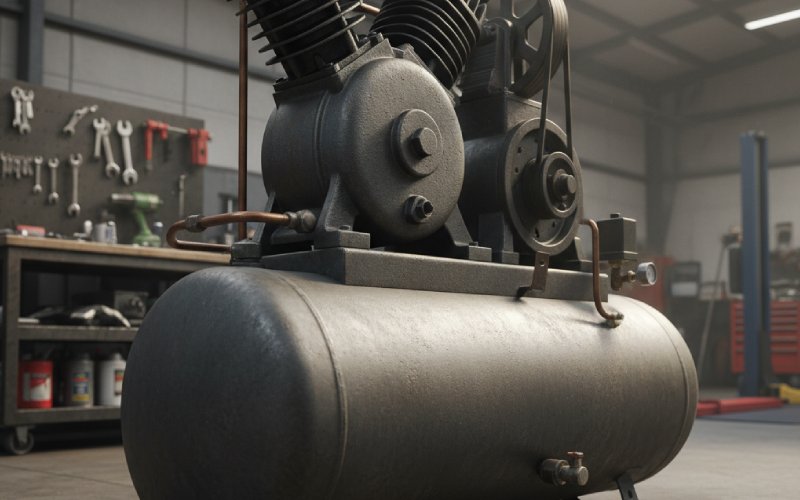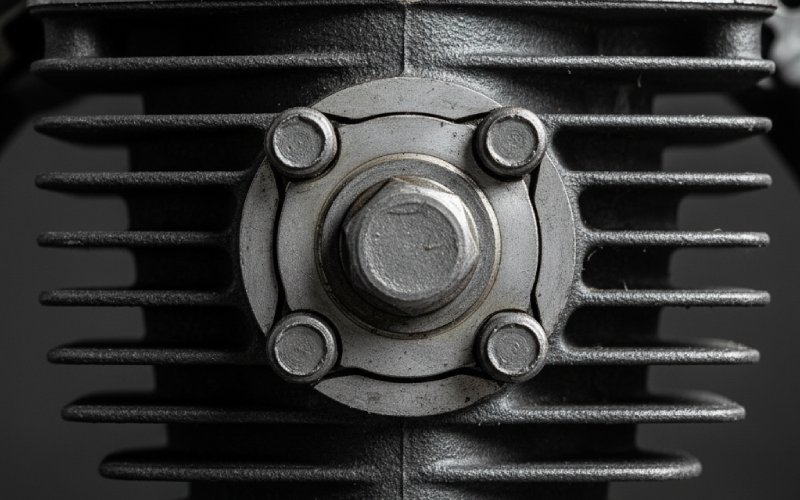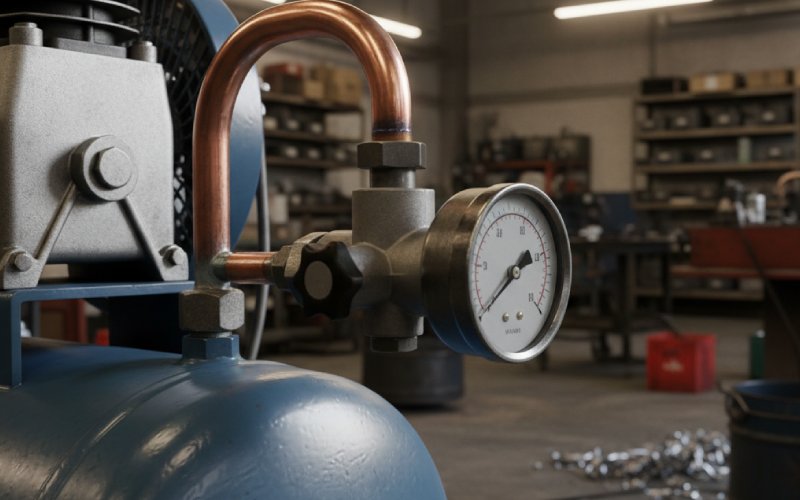Let Sino's Lamination Stacks Empower Your Project!
To speed up your project, you can label Lamination Stacks with details such as tolerance, material, surface finish, whether or not oxidized insulation is required, quantity, and more.

Have you ever asked yourself what powers the air tools at your local car shop? Or how big factories get the high-pressure air they need for their machines? The answer is often a strong machine. It is called a reciprocating air compressor. This kind of compressor uses a piston. The piston moves back and forth to squeeze air. This makes it very useful for many jobs.
This article is your easy-to-read guide. We will show you exactly how this useful compressor works. You will learn about its parts and all the good things about it. You will also learn the places it is used most often for different kinds of work. When you are done reading, you will understand everything you need to know about a reciprocating compressor. This information will help you pick the right one for your job. Or, you can just understand how it all works a little better.
A reciprocating air compressor is a machine. It uses a piston to make air pressure higher. You can think of it like a bicycle pump. But it is much bigger and more powerful. The main part is the piston. The piston moves up and down inside a part called a cylinder. This back-and-forth movement is called a reciprocating motion. This is how the “reciprocating compressor” got its name. This kind of compressor is very common. You can find these air compressors in many different places.
This machine is a type of positive displacement compressor. That’s a special name. It just means the compressor pulls in a set amount of air into a chamber. Then, it makes that chamber smaller. When the space gets smaller, the air gets squeezed. This action to compress the air makes its pressure go up. Because it uses a piston to reciprocate, this machine is also called a piston compressor. A lot of air compressors work in this way. This simple design that works well makes the reciprocating compressor a very useful tool for many jobs.
The main job of any compressor is to take in air at one pressure. Then it pushes the air out at a higher pressure. A reciprocating air compressor does this job very well. The piston must reciprocate, or move back and forth, to do its work. This movement is what makes the whole thing work. There are other kinds of compressors, like rotary screw compressors. But the reciprocating compressor is picked a lot because it is so good at making high pressure.
So, how does the compressor work? It all starts with an engine or an electric motor. The motor turns a part called a crankshaft. This works a lot like a car engine. The crankshaft has a part called a connecting rod attached to it. The other end of this connecting rod connects to the piston. When the crankshaft spins, it pushes the connecting rod. This makes the piston move. This is how the machine changes the spinning motion of the motor into the back-and-forth motion of the piston.
This movement is what makes the compressor do its job. The piston has to reciprocate inside a cylinder that it fits in tightly. As the piston moves one way, it makes a vacuum. This vacuum pulls air in. When it moves the other way, it squeezes that air. It pushes the air into a small space. This is the main way the compressor is able to compress gas or air.
This process happens very, very fast. The piston might reciprocate hundreds or thousands of times every minute. Each time the piston moves, it finishes one full job of pulling in and pushing out air. This keeps happening over and over. This action fills up a storage tank with compressed air. This stored air is then ready to be used for many different kinds of tasks. The simple way this compressor works is a big reason why so many people use it.

To really understand how a compressor works, you need to know about its main parts. A reciprocating compressor is made of a few important parts that all work together. Each part has a special job to do during the compression time.
Here are the most important parts of a regular reciprocating air compressor:
| Part | What It Does |
|---|---|
| Piston | A metal piece that moves up and down inside the cylinder to compress the air. |
| Cylinder | The chamber where the piston moves. This is where the air compression happens. |
| Crankshaft | A shaft that is turned by the motor. It changes the spinning motion into back-and-forth motion for the piston. |
| Connecting Rod | A part that connects the crankshaft to the piston. It lets them move together. |
| Inlet Valve | A one-way valve. It lets air into the cylinder when the piston moves down. |
| Discharge Valve | A one-way valve. It lets high-pressure air out of the cylinder when the piston moves up. |
| Electric Motor | The part that gives power to the crankshaft and the whole compressor. |
These parts are the most important parts of the piston compressor. The quality of these parts and how they are made decides how well and how long the machine will work. A good reciprocating compressor will have strong parts. These parts can keep working for a long time without breaking. Learning about these parts helps you see how simple but strong these air compressors are.
The job of making compressed air happens in two main steps. These steps are also called “strokes.” A stroke is one full movement of the piston, from the very top to the very bottom, or from the bottom to the top. Let’s look at what happens inside the cylinder during each stroke.
1. The Intake Stroke (Suction Stroke): The cycle starts when the piston moves down inside the cylinder. This movement makes more space in the chamber above the piston. This makes the pressure go down. This creates a vacuum effect. The pressure outside the compressor is now higher than the pressure inside the cylinder. This difference in pressure makes the inlet valve open. As the valve opens, fresh air is pulled into the cylinder. The discharge valve stays closed during this stroke.
2. The Compression Stroke (Discharge Stroke): After the piston gets to the bottom of its stroke, it starts to move back up. This upward movement starts to compress the air that is inside the cylinder. As the piston moves, the space gets smaller. The air pressure goes up very fast. The inlet valve closes so the air cannot get out. The pressure inside the cylinder gets higher than the pressure in the storage tank. When this happens, the discharge valve opens. The piston pushes the air that has just been squeezed out through the discharge valve and into the tank. Then, the cycle starts all over again. This is how the compressor makes powerful air.
Not all reciprocating air compressors work in the exact same way. One big difference is if they are “single-acting” or “double-acting.” This name tells you how the piston is used to compress the air inside the cylinder.
A single-acting compressor is the kind you see most often. This is especially true for smaller air compressors. In this design, the compression only happens on one side of the piston. As the piston moves down, it pulls in air. As it moves up, it compresses that air. The other side of the piston does not do any work. This design is simple and easy to make. This makes it great for workshops and smaller jobs in factories. A single-acting reciprocating compressor is a very hard worker.
A double-acting compressor is different. It has more parts and it works better and wastes less energy. In this kind of machine, both sides of the piston are used to compress air. It has inlet and discharge valves on both ends of the cylinder. When the piston moves forwards, it squeezes air on one side and pulls in air on the other side. When it moves backwards, the same thing happens on the other side. This means the compressor is always working. This makes it very good for non-stop, tough jobs in big factories.
There are different kinds of compressors that you can buy. So, why would you choose a reciprocating compressor? The reason is that it has a special set of good things about it. This compressor gives you a good mix of power, low price, and strength. This works for many different jobs.
Here are some of the main good things:
These good things make the reciprocating compressor a top choice for many people. This type of compressor gives you a lot for your money.
A reciprocating air compressor can be used for many things. You can find these strong machines working in almost every kind of business. They can make high-pressure air. This makes them very important for a huge number of jobs. They are one of the kinds of air compressors you will see most often.
In car repair shops, these air compressors power everything. They power tools like impact wrenches and paint sprayers. A small workshop or a large repair shop will almost always have a reciprocating compressor. In factories, they are used to run machines, control automatic systems, and clean parts. This compressor is used for a lot of big jobs.
Here are just a few examples of where you might see a reciprocating air compressor at work:
The list of different uses is very long. From small businesses to big factories, the reciprocating compressor is a very important tool. This machine is used in many kinds of businesses because you can count on it.

Yes, there are several kinds of reciprocating compressors. We can put them into groups based on a few important things about them. Knowing these differences can help you find the best compressor for your work. The main types of reciprocating compressors are grouped by how many times they squeeze the air and how they are kept oily.
One way to group them is by the number of compression stages. A single-stage compressor squeezes the air one time. The piston compresses the air and sends it right to the storage tank. This design is good for pressure up to about 150 PSI. A two-stage compressor squeezes the air two times. After the first time it is squeezed, the air is sent to a second, smaller cylinder for more squeezing. This lets the compressor get to a much higher pressure, often over 200 PSI. Two-stage models are also better at saving energy because they cool the air between the two stages.
Another big difference is how they are oiled. Oil-lubricated compressors use oil. This helps the piston and cylinder keep moving smoothly. These are the most common kind and are known to last a long time. But, a little bit of oil can get into the compressed air. For jobs where clean air is very important, like in the food or medical business, an oil-free compressor is used. These use special materials, like Teflon-coated rings on the piston. This means they don’t need oil to run smoothly.
Picking the right compressor is very important. The right machine will do the job well. It will also last a long time. The wrong one can make you unhappy and waste money. When you are looking for a compressor for your job, there are a few things to think about.
First, think about pressure (PSI) and air flow (CFM). PSI (Pounds per Square Inch) is how much force the air has. CFM (Cubic Feet per Minute) is how much air the compressor can give you. You should check what your tools or machines need. Always pick a compressor that gives you a little more PSI and CFM than you need.
Next, think about where it gets its power. This is the power source. Most air compressors use an electric motor. But some bigger models for factories or ones you can carry around may use a gas engine. Make sure your workshop has the right kind of power plugs for the compressor you pick. Also, look at the size of the storage tank. A bigger tank means the compressor motor will not have to run as much. This is better for jobs where you use air for short times. Choosing the right compressor means picking the machine that fits your exact job.
A reciprocating compressor is a tough machine. But it needs regular care to stay in good shape. Good care will make sure you can count on it. It will also make it work for many years. Luckily, the simple jobs are easy and do not take a lot of time. Putting in the right oil is very important for many models.
For an oil-lubricated compressor, the most important job is to check the oil level a lot. Just like a car engine, the pump needs oil to run smoothly. You should also change the oil at regular times. Another important job is to drain water from the storage tank every day. When air is compressed, the wetness in the air turns into water. This water gathers at the bottom of the tank. If you don’t drain it, the tank can get rusty from the inside.
You should also clean or change the air intake filter at regular times. A dirty filter makes the compressor work harder. This wastes energy and can make it get too hot. Lastly, check for any air leaks in the hoses and connections. A small leak can make your compressor run much more than it has to. If you do these simple steps, you will keep your reciprocating air compressor working well for a very long time.